on fuel cells, eFuels, a sensor to know, & aging vehicles
Don’t count out fuel cell vehicles. . .eFuels can extend the lives of ICEs. . .new sensor tech for autonomous vehicles. . .vehicles are getting older. . .Kia contributes to ocean cleanup. . .Miata. . .student set amazing speed record
The “Other” Electric Vehicle
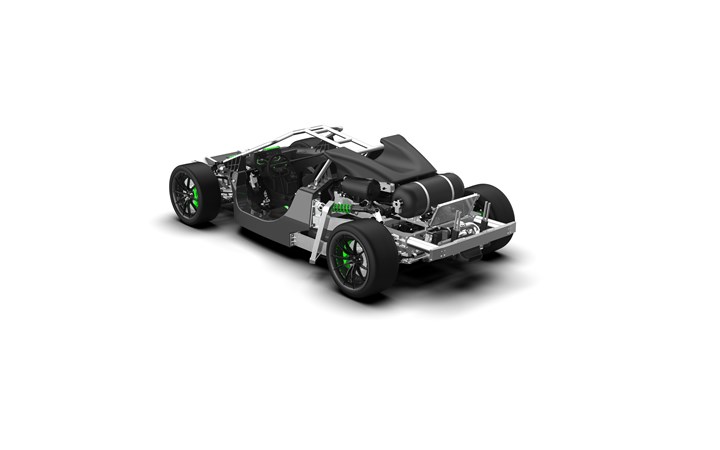
WAE fuel cell platform. Supplier suggests that this could help get FCEVs to market more quickly. (Image: WAE)
Sometimes you’ll see “BEV” rather than “EV” when the topic is electric vehicles.
One reason for that is simply because whether it is a Model Y or a Lightning, the energy for the motors is stored in a battery. B.
But there are also FCEVs: fuel cell electric vehicles.
Here the energy for the motors—and conceivably the very same motors found in a BEV—is stored in the form of hydrogen, that is then processed by a fuel cell stack to create electricity (and water, the emissions). FC.
While hydrogen had been at the forefront of R&D work by companies including General Motors and Honda, it has been simply eclipsed by BEV efforts, undertakings and investments.
Which doesn’t mean it is gone, however.
Hydrogen in the Desert
BMW recently announced its hydrogen pilot fleet—based on the BMW iX5—that’s been running in Europe, Japan, Korea, China, the U.S., and the Middle East since February, managed to deal with sand, dust and temperatures as high as 113 degrees F in the United Arab Emirates.
And nearly coincident with that announcement BMW CEO Oliver Zipse said in a speech at the China’s World New Energy Vehicle Congress that took place in Munich during the IAA, that just as China has facilitated the growth of BEVs, “The same policy incentives for electromobility are needed for hydrogen to make a breakthrough.”
BMW is pursuing what it terms a “technology open” approach to propulsion, “adapting to different customer requirements, infrastructure standards and political and regulatory landscapes in the various regions of the world.”
Trucks & Beyond
While there seems to be interest in using fuel cells for heavy-duty trucking by companies including Hyundai, Toyota*, Nikola, Paccar, Cummins, and others, the BMW fleet shows a focus on light-duty passenger vehicles.
An FCEV platform for passenger vehicles—sporty ones—was recently revealed by WAE Technologies. Its EVRh platform features a composite structure, a 120-kW fuel cell, and a battery capable of discharging 430 kW.
WAE, which was originally spun out of Williams Grand Prix Engineering Ltd., reckons that the EVRh would turn in a sub-2.5-second 0 to 62 mph time.
WAE claims that its platform could help reduce time and costs for OEMs—traditional or startup—who are interested in going FCEV.
==
*The fuel cells in the BMW iX5 Hydrogen are sourced from Toyota. BMW and Toyota have been collaborating on fuel cell drive systems for 10 years.
///
Another Fuel to Keep in Mind
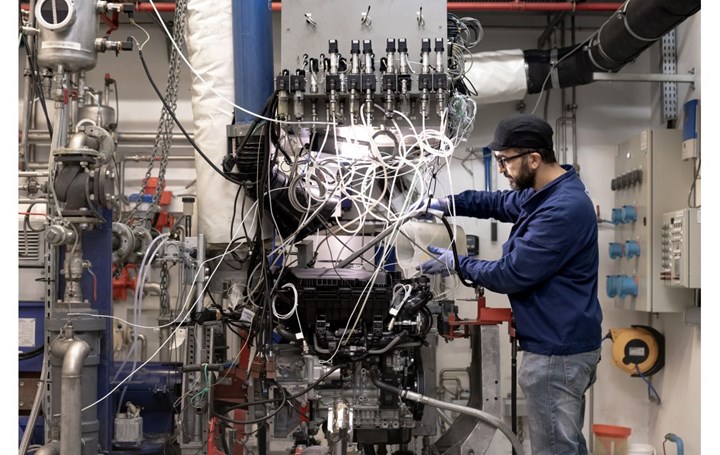
Stellantis engineer working on eFuels. (Image: Stellantis)
Liquid fuel.
Not exactly gasoline. But something that goes through a hose into a vehicle, not a wire.
Specifically, eFuel.
Porsche, for example, is a company that is so interested in it that it has invested more than $100-million in help making it real.
In late December 2022 Porsche and partners opened a facility in southern Chile to produce the fuel that allow combustion engines to operate “nearly CO2 neutral.”
Although the amounts of fuel the plant will produce will be low—about 145 million gallons near the end of the decade (fun fact: according to the U.S. Energy Information Administration, the U.S. consumed 369 million gallons of gasoline per day in 2022), the opportunities are high.
Michael Steiner, member of the Executive Board for Development and Research, Porsche AG:
“The potential of eFuels is huge. There are currently more than 1.3 billion vehicles with combustion engines worldwide. Many of these will be on the roads for decades to come, and eFuels offer the owners of existing cars a nearly carbon-neutral alternative. As the manufacturer of high-performance, efficient engines, Porsche has a wide range of know-how in the field of fuels.”
Earlier this month an announcement was made by Aramco and Stellantis that is more applicable to those who happen to have cars than aren’t, say, 911s. (Probably something akin to whatever is in your driveway right now.)
The “energy and chemicals” company and the automaker (and “mobility provider”) have determined that 24 Stellantis internal combustion engine families that are in European vehicles sold since 2014—some 28 million vehicles—can use eFuel.
Aramco is working on developing both the chemistry for the drop-in synthetic fuel and two manufacturing facilities to produce it.
Ned Curic, Stellantis Chief Engineering and Technology Officer:
“Drop-in eFuels can have a massive and almost immediate impact on reducing the CO2 emissions of the existing vehicle fleet, offering our customers an easy and economically efficient option to reduce their carbon footprint — one as simple as choosing a different fuel pump at the station, with no additional modification to their vehicles.”
Yes, all of the aforementioned companies are pursuing vehicle electrification, but (1) the number of existing cars with ICEs is huge and not shrinking anytime soon and (2) there is a lot of existing investment in making thermal engines and providing the infrastructure to fuel them, so if there can be a reduction in emissions—Stellantis and Aramco say that using the drop-in eFuel can reduce carbon emissions “by at least 70% on a lifecycle basis” compared with conventional gas—then why not?
///
Another Tech to Know: HADAR
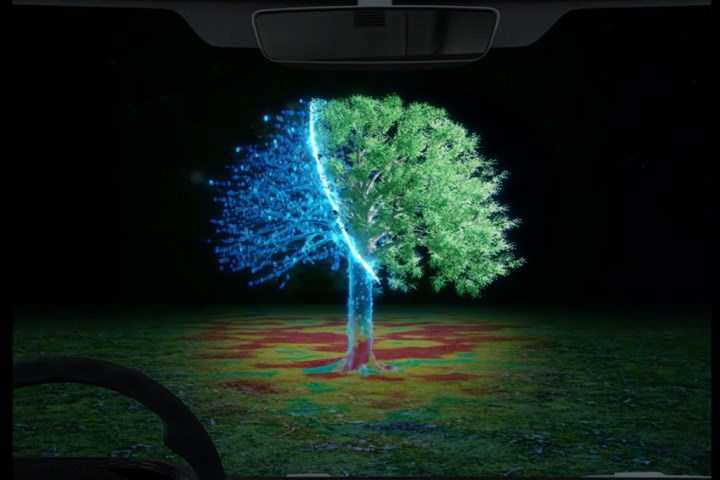
An image created with a HADAR sensor. Plenty of fidelity. (Image: Purdue University)
While you might not know the acronym stands for “light detection and ranging,” you’ve heard of LiDAR, a tech that facilitates self-driving vehicles. Then there are radar, for “radio detection and ranging”, and sonar, “sound navigation and ranging.”
Coming to the list is HADAR, or “heat-assisted detection and ranging.”
Work on this tech is being conducted at Purdue University, where this thermal sensing approach was developed by Zubin Jacob, Elmore associate professor of Electrical and Computer engineering, and Fanglin Bao, a research scientist at the university.
Just saw a ghost
Thermal imaging isn’t new. It offers advantages over other sensors as it isn’t affected by darkness, inclement weather or solar glare.
But passive thermal imaging has limits.
Bao said: “Objects and their environment constantly emit and scatter thermal radiation, leading to texture-less images famously known as the ‘ghosting’ effect.
“Thermal pictures of a person’s face show only contours and some temperature contrast; there are no features, making it seem like you have seen a ghost. This loss of information, texture and features is a roadblock for machine perception using heat radiation.”
And if that is used for an autonomous vehicle, this ghosting can be problematic.
Bao:
“HADAR vividly recovers the texture from the cluttered heat signal and accurately disentangles temperature, emissivity and texture, or TeX, of all objects in a scene. It sees texture and depth through the darkness as if it were day and also perceives physical attributes beyond RGB, or red, green and blue, visible imaging or conventional thermal sensing. It is surprising that it is possible to see through pitch darkness like broad daylight.”
No ghosts.
Challenges ahead
While the researchers anticipate automotive application for HADAR at some point, they realize that there are some challenges ahead.
For example, the “hypercam” that is used has two main components: a hyperspectral module and a focal plane array.
According to Bao: “The hyperspectral module is usually bulky. Some focal plane arrays need a low-temperature working environment, and the cooling system is also bulky.”
So they have to figure out how to minimize the bulk for both.
Bao said that the system they’re working with is, “roughly speaking, a couple of cubic feet in size and tens of kilograms in weight.”
He thinks it needs to get down to the size and weight of a camera to get widespread application.
Cost, of course
And he is well aware of that other factor in the auto industry that makes or breaks a technology:
“The automotive industry is very sensitive to the sensor price. The functionality-cost balance is indeed a remaining challenge of HADAR. I hope in the next five years HADAR at the price level of $10K can start playing unique roles that cannot be replaced by other sensors.”
But this doesn’t mean the elimination of the other sensors. According to Bao:
“Practically speaking, I think HADAR would be supplemental to other sensors. For example, LiDAR has its unique advantage of accuracy. Cameras have wonderful performance in daylight. Combining them together would be a better solution to the automotive industry than using any of them to replace others.”
///
Lots of Vehicles (And Not All New)
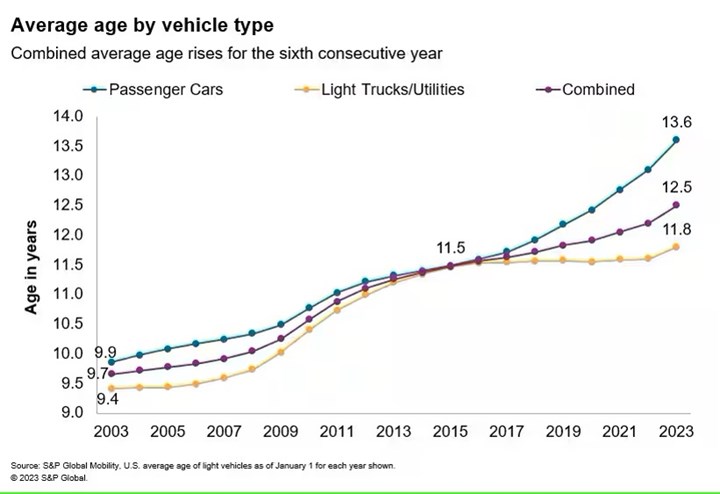
Yes, cars on the road are now teenagers. (Image: S&P Global Mobility)
While it might seem that one of the consequences of the pandemic is that vehicles stopped being acquired, and while there was admittedly a drop off of vehicles built and sold, there was still a remarkable aggregation of sheet metal.
The Dept. of Energy has compared the growth of the U.S. population, the number of licensed drivers, and the number of vehicles on the road from 1960 to 2021.
It discovered that the population was 1.8 times higher in 2021 than 1960, the number of licensed drivers was 2.7 times higher. . .and the number of vehicles was 4.3 times higher.
A non-trivial part of that increase in vehicles is a result of people holding on to them longer.
Nearly Teenagers
S&P Global Mobility has calculated that the average age of light vehicles on the road today in the U.S.—and it estimates there are some 284 million in operation—is 12.5 years.
This is the sixth straight year of an aging car parc and a three-month increase in age over the average age in 2022.
Todd Campau, associate director of aftermarket solutions for S&P Global Mobility, says, "There are almost 122 million vehicles in operation over 12 years old."
And the research firm calculates the volume of vehicles ages six to 14 will increase by 10 million units by 2028, and that vehicles over age six will account for about 74% of the fleet in that year.
What’s more, in 2028 they estimate that “at least” 70% of the vehicles in operation will be light trucks/utilities.
You may have noted Campau’s title includes “aftermarket.”
Given the number of aging vehicles out there, aftermarket-related firms certainly have tremendous opportunities.
And EVs?
S&P Global Mobility found that between 2013 and 2022 some 2.3-million EVs were registered. Of that number, 2.12 million are still on the road.
That means 6.6% have left the fleet.
When that’s compared with vehicles operating with combustion engines, during that same period 158 million were sold and 149.8 million are still in operation.
That means 5.2% have left the fleet.
Yes, a greater percentage of EVs are no longer rolling compared to ICE vehicles.
///
Kia’s Critical Partnership
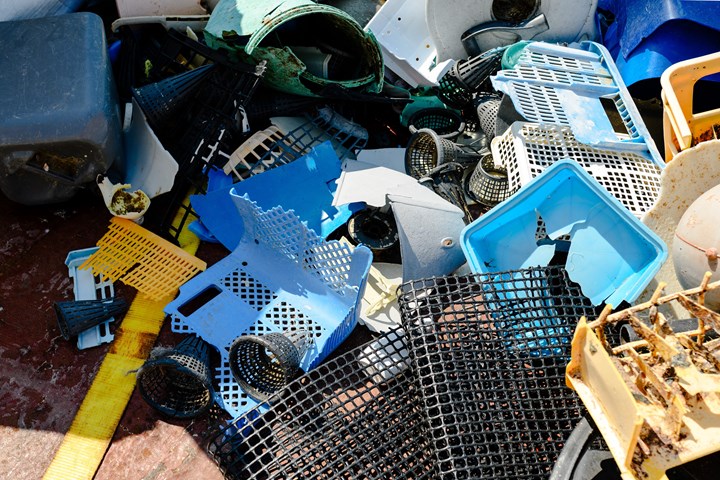
Tons and tons of this plastic waste have been taken out of the ocean. And there are tons and tons to go. (Image: Kia)
Vehicle manufacturers around the world have an array of sponsorship and partnership arrangements with organizations and events, many of which are related to sports (i.e., teams, tournaments).
Kia has its share of those.
But it has one sponsorship that is arguably more important.
With The Ocean Cleanup.
It is a non-profit organization based in Rotterdam with a goal that is as simple as it is massive: remove 90% of the floating ocean plastic by 2040.
The massive part can be realized by knowing there is what is called the “Great Pacific Garbage Patch,” which floats around between California and Hawaii.
- It has a surface area of 1.6-million square kilometers—twice the size of Texas.
- It has a mass of some 80,000 tonnes.
- It consists of 1.8 trillion pieces of plastic: hard plastics, sheet, lines, ropes, fishing nets, pre-production plastics, foam fragments.
Last month The Ocean Cleanup collected 55 tons of plastic from the Garbage Patch.
A record haul.
Kia is going to use some of the materials from this catch—after they’ve been recycled, of course—for future products.
The company already uses recycled and eco-friendly materials in its vehicles.
The EV9, for example, uses, by weight, 75 pounds of the stuff.
Realize that plastic waste continues to be thrown in the oceans, so this is a nearly Sisyphean task.
Using the waste materials is important. So is collecting it. Credit to Kia for this.
///
2023 Mazda MX-5 Miata Grand Touring

The Mazda MX-5: one of the few vehicles that still provides driving enjoyment and a manual transmission. Fun, yes. Utility, not so much. (Image: Mazda)
In mid-August Ford announced that it will be installing its BlueCruise hardware on some 500,000 Ford and Lincoln brand 2024 model year vehicles. This will provide owners with the opportunity to access hands-free highway driving capability.
The BlueCruise software allows hands-free operation in stop-and-go driving, going around curves, and driving on narrow roads.
Not only is it expanding the availability of the technology, but it is also offering it with various subscription plans, ranging from $2,100 for three years at time of ordering or purchase to a monthly plan for $75.
When Ford made the announcement I was driving the Mazda MX-5 Grand Touring.
And it occurred to me that the diminutive two-seat cloth-top convertible sports car will soon need something like the Society for the Preservation of the Penny-Farthing to keep it going.
In the first half of 2023 Mazda sold 5,513 MX-5s—the cloth top and the folding hard top versions. In all of 2022 it delivered 6,171 in the U.S. market, so if it keeps at that pace it will do much better in 2023.
Yet if the second half is as good as the first half was, it would still be 11,026 vehicles for the entire year for a vehicle that has a likely transaction cost under $36,000.
Cars of this type simply aren’t all that popular.
For example, Toyota delivered just 5,263 GR86 models during the first half of 2023—fewer than the MX-5 (but a lot more for all of 2022: 11,996 GR86s vs. the 6,171 MX-5s).
It is hard to make a fair comparison to anything when it comes to how small these numbers really are.
It is easy to understand how Toyota can do it, given its scale.
It is hard to understand how Mazda does it because for the first half of 2023, even though its total sales were up 28.7%, it still only moved 183,783 vehicles.
Toyota sold a combined number of SUVs and trucks of 113,920—in June.
But the Miata, which goes back to 1989, is the spiritual soul of Mazda.
Meanwhile, back at the car. . .
To go back to the BlueCruise announcement in the context of this car—and it is a car, not a crossover (of which Mazda now has several)—it struck me that as I worked through the gears—clutch in/select gear/accelerate/rinse/repeat/then do it in the other direction—that knowing how to work a manual is, well, quaint.
While that will raise the hackles of many enthusiasts (and let’s be frank: there aren’t all that many, comparatively speaking), cars that run, say, at Le Mans have sequential gearboxes, so the drivers aren’t depressing and releasing clutch pedals such that their calves would otherwise become the size of Popeye’s forearms.
To be fair, the Miata is available with an automatic mated to the 181-hp, 2.0-liter four with variable-valve timing.
Zooming
The cloth-top and manual bring the curb weight of the car to 2,341 pounds, so that 181 hp is certainly fit for zooming around town or putting the double pinion electric power-assisted steering to work on the twisty roads that the Miata really wants to drive on. Which, of course, makes it somewhat problematic for those who, say, live in the Midwest, where such roads are the sorts of things that you have to assiduously seek.
It is a small car, measuring 154.1 inches long, 68.3 inches wide and 48.6 inches high. When you climb into it—although with a ground clearance of about 5 inches, climb may not be the appropriate word—it is pretty much like you’re sliding into and then enveloped by the Miata. It is in keeping with Mazda’s Jinba-Ittai approach, or the relationship between a rider and a horse. A oneness. This is not driving a couch.
Yes, the Miata is fun to drive.
But for many people, “getting to work” or “getting the kids to school” or “getting more groceries than can be accommodated by a single bag” are things that are more important than “fun.”
So it all comes down to a question of whether you can afford ~$35K to have fun in a 2023 Mazda MX-5 Miata Grand Touring.
///
The Kids Are Alright
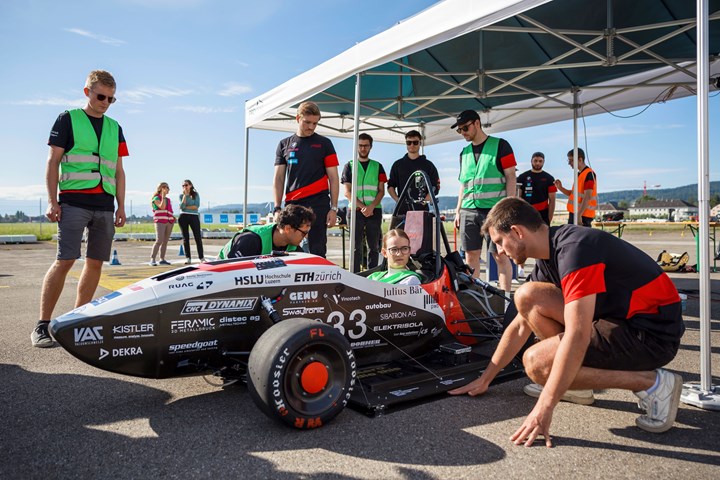
That tiny car goes like a full-size rocket. (Image: Alessandro Della Bella / ETH Zurich)
This is impressive: 0 to 62.15 mph in 0.956 seconds.
That’s a Guinness-certified world record for acceleration.
It was set by members of the Academic Motorsports Club Zurich (AMZ), which consists of about 30 students from ETH Zurich and the Lucerne University of Applied Sciences and Arts.
The electric vehicle, driven by student Kate Maggetti, reached that speed in just 12.3 meters.
The vehicle is constructed with carbon fiber and aluminum honeycomb.
It weighs just 309 pounds.
Perhaps more impressive than the speed is:
- The students developed the printed circuit boards, battery and chassis
- They developed the four-wheel hub motors that provide the car, named “mythen,” 240 kW of power
And speaking of power: Dario Messerli, head of aerodynamics at AMZ, said, “Power isn’t the only thing that matters when it comes to setting an acceleration record—effectively transferring that power to the ground is also key.”
Apparently the kind of aero kit that is used on things like Formula One cars work once the vehicles reach a certain speed. Given how quickly the mythen reached its top speed—12.3 meters is about 40 feet, and to picture that, know that the length of a pickleball court is 44 feet—it was necessary to develop a vacuum-like device that provides downforce through suction to keep the car planted.
Record upon record
Seems that European university students are interested in setting acceleration records. The AMZ team held the record in 2014 and 2016. In both cases students from the University of Stuttgart took it.
In September 2022 the University of Stuttgart set a new record 1.461 seconds.
Obviously the ATZ 0.956-second performance demolished that.
One wonders how long it will stand.
====
RELATED CONTENT
-
GM Is Down with Diesels
General Motors is one company that is clearly embracing the diesel engine.
-
Engineering the 2019 Jeep Cherokee
The Jeep Cherokee, which was launched in its current manifestation as a model year 2014 vehicle, and which has just undergone a major refresh for MY 2019, is nothing if not a solid success.
-
When Automated Production Turning is the Low-Cost Option
For the right parts, or families of parts, an automated CNC turning cell is simply the least expensive way to produce high-quality parts. Here’s why.


.jpg;width=70;height=70;mode=crop)






